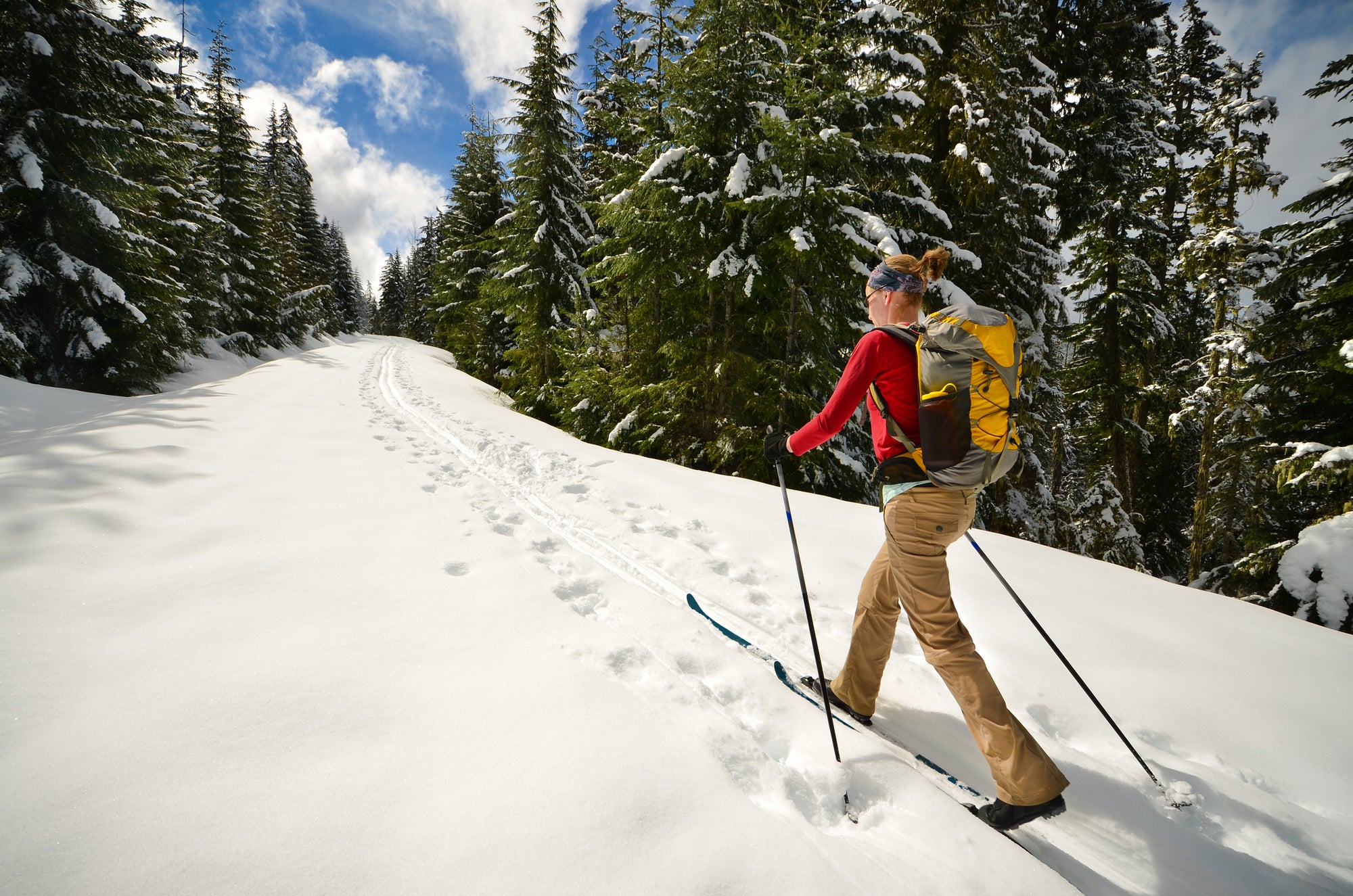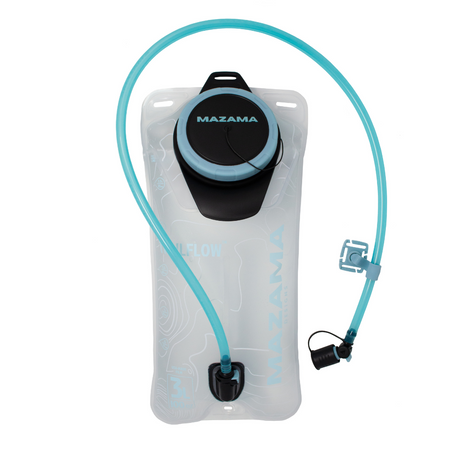How to Plan Your First Backcountry Cross Country Ski Adventure
December 07 2022 – Matt Hoskins

There’s nothing like a fresh snowfall to emphasize the beauty of the winter season. While it’s tempting to hole up indoors, the winter wonderland outside is hard to resist. There are a lot of ways to enjoy the outdoors during the winter, but there’s nothing better than backcountry cross country skiing through snowy woods and meadows.There’s a lot to love about backcountry cross country skiing: It’s fantastic exercise, it lets you explore off-trail, and — compared to alpine (downhill) skiing, it’s relatively inexpensive. Plus, it’s just plain fun.
Below, read our tips for planning, packing for, and executing your first backcountry cross country ski adventure.
What is Backcountry Cross Country Skiing?
Cross country skiing — often used interchangeably with Nordic skiing — uses different equipment than alpine, or downhill, skiing. When cross country skiing, your boots attach to your skis at the toe while your heel remains free. Cross country skis are narrower and lighter — and built to use over flatter terrain.
There are several styles of cross country skiing. Classic skiing takes place on groomed trails using very narrow, long skis. Backcountry cross country skiing takes place off-trail — through woods, meadows, golf courses, or anywhere with enough snow — and requires a wider ski with more stability.
If you’re uncomfortable on skis or have never tried cross country, you may decide you want to try classic skiing first. But if you have a good sense of adventure, can walk several miles, and can handle a few falls, there’s no reason you can’t try backcountry cross country skiing as a beginner.
Note: Backcountry cross country skiing is not the same as alpine touring — which involves lots of elevation change, extra equipment, and avalanche knowledge. This blog covers the more beginner-friendly activity of backcountry cross-country skiing.

Equipment for Cross Country Backcountry Skiing
As we mentioned before, backcountry cross country skiing requires specialized equipment to make traversing off-trail less of a hassle — and more of an adventure.
Below is a quick breakdown of the gear you’ll need.
Clothing
There’s nothing special about the clothes you wear for backcountry skiing — your regular cross country (or winter exercise) wardrobe should do. The key is to dress in layers, because you’ll warm up fast. Here are a few items to make sure have:
- Wicking, breathable base layers: As you’ll soon find out, cross country skiing is good exercise, and you’ll work up a sweat quickly. The drier you are, the easier it is to maintain a comfortable body temperature.
- Gaiters: Unlike classic skiing, backcountry skiing means trudging through deep, powdery snow. Gaiters will help keep snow out of your boots.
- Accessories: Wear or bring a warm hat, gloves or mittens, and a neck gaiter.
- Eye protection: When sunlight reflects off the snow, sunglasses are key. If it’s windy or snowy, you might prefer goggles.
- Extra layers: Since you probably won’t have access to a heated shelter or lodge, pack extra layers in your backpack. If something were to happen — an injury, getting lost, getting wet — you’ll need to stay warm.
Emergency kit
Prepare for the unexpected with a few emergency essentials:
- Navigation, including map and compass or GPS
- Phone for communication
- Repair kit, including duct tape, screwdriver, cable ties, multi-tool, and ski wax
And if you’re traveling more than a couple of miles in the backcountry, bring these extras:
- Avalanche shovel
- Space blanket
- Fire starter
- Backup power source
Skis and Accessories
The staff at a ski shop or rental facility will be a huge help in making sure you choose the right gear. But here’s a quick overview of what you’ll need.
- Skis: Backcountry cross country skis are wider and shorter than what you’d use on a groomed trail, and often have metal edges to give you more control.
- Poles: Backcountry poles have bigger baskets to keep them from sinking into deep snow off-trail.
- Boots: You boots need to be compatible with your bindings. You’ll most likely come across NNN or NNN BC boots and bindings — make sure your boots and bindings are the same. NNN BC bindings are slightly wider and designed specifically for backcountry skiing.
- Backpack: You’ll need storage for food, water, clothes, and emergency supplies — and you’ll also need good mobility while wearing it. A hiking backpack works well.
Snacks and water:
Don’t underestimate the amount of food and water you’ll need to fuel your backcountry adventure. Pack the following:
- Snacks: Energy bars, trail mix, jerky, or other convenient snacks.
- Fluids: You’ll need water, but you may also want a hot drink. Use a thermos or insulated bottle to keep liquids hot.
- Insulated reservoir: Keep water in an insulated reservoir — with an insulated hose — to make sure your water doesn’t freeze while you’re out.
- Soft bottle: If you’re traveling light and water within easy reach, fill a soft water bottle and stow it in an interior pocket. Your body heat will keep the water from freezing.

Plan Your Cross Country Backcountry Adventure
Like any other outdoor adventure, it’s important to plan before you go. Take the following steps before heading outside:
Rent gear, if needed.
If you don’t have skis, poles, and boots, you’ll need to find a shop or resort that rents them. Store associates or rental staff will be able to help you choose the right equipment for backcountry skiing.
Choose a trail.
Ask around at a local outdoor shop, find an online forum, or consult a guidebook for trail information. You might even think about your favorite summer hiking trails — though make sure they’re appropriate for skiing. Sharp turns, steep hills, and drop-offs are not beginner-friendly.
Try to pick a trail other people use. You don’t want to be out on your own if something goes wrong. Make sure you pick a trail with cell service in case you do find yourself alone and in need of help.
Choose something relatively flat — with plenty of snow and lots of clearance. A flat, open meadow is a great place to start. Keep in mind, a seemingly small hill on skis is a bigger obstacle than you might expect.

Aim for a trail about 3-6 miles in length. An out-and-back trail — rather than a loop — is best for beginners who only want to break trail once. If you can pick a route with a shelter for a covered snack break, even better.
Check the forecast.
Before you head out, make sure to check the weather. Trails look unfamiliar in the snow and are tough to navigate during windy, whiteout conditions. Go out earlier in the day to take advantage of the daylight.
Share your plan.
Bring a friend on your first outing. There’s safety in numbers when adventuring outdoors — especially in the winter. Let someone else know where you’re heading and when you’ll be back so they can make sure you return.
Hit the Trail
By the time you’re suited up and properly prepared, you’ll be dying to get out and enjoy the snow. But before you click into your skis and leave the trailhead, there are a few tips to consider:
- Remember your plan, and stick to it. As with any outdoor pursuit, it’s tempting to push your limits. But if you’re new to the activity, adhere to your plans and play it safe.
- Pace yourself. The wonderful thing about cross country skiing is that you can get great exercise while having too much fun to even notice. But if you work too hard on the ski out, the ski back might be more than your bargained for. Don’t forget to pace yourself, stop for breaks, and enjoy the views.
- Regulate your temperature. When you’re working out in cold weather, you’ll warm up fast and cool off even faster. Keep your temperature in check by taking off layers when you’re warm and adding them as you cool off.
- Practice falling — and getting up — at the trailhead. It sounds silly, but falling isn’t uncommon while cross country skiing, and getting up can be tricky. By “practicing” ahead of time, you’ll know what to do when you inevitably take a spill.
- Have fun! Enjoy getting outside during this special time of year, and share your new hobby with friends and family.

